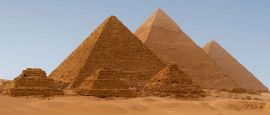Egypt Weather, climate and geography
Weather & climate
Egypt is a huge country with plenty of variety in its climate; when it’s chilly and wet in Alexandria, it can be ravishingly hot in Aswan.
The best time to visit most sights, including the pyramids and the Valley of the Kings, or diving in the Red Sea, is from February to April and October to November. During these months the heat reminds you that it's the ‘Land of the Sun', but not too hot to be enjoyable. At this time, the skies and sea are a perfect blue. The downside is that these are the most popular times of the year for visitors.
In April, the hot, dusty khamsin wind blows from the Sahara, making touring of sights potentially troublesome; during an intense sand storm, vision may be reduced to a few metres. During the hot, dry summers (June-August) there’s always the risk of dehydration and heat exhaustion, which might confine visitors indoors during the early afternoon.
Winters (November-February) are usually mild and often overcast, leaving the desert and its ancient monuments looking lacklustre. Rainfall is negligible except on the coast.
Geography
Traditional home of the roaming Bedouin, most of Egypt's landmass is comprised of flat, mostly featureless desert, supportive of minimal vegetation.
The Mediterranean Sea forms Egypt's northern border, bringing cooler weather to the seaboard city of Alexandria and providing a coastal getaway for Cairo's residents. To the east, lies the mountainous Sinai Peninsula, which borders Israel and the Palestinian Territories; to the south, the deserts of Egypt quietly roll into the deserts of Sudan; to the west, the Great Western Desert forms an almost seamless wilderness through Libya and beyond.
Sinai is divided from the main landmass of Africa by the country's busy shipping lane, the Suez Canal. For centuries, however, it was the River Nile, plied by felucca (traditional Nile sailing boats), that provided the main conduit for trade along the country's length. Railways and roads now compete for that distinction, but the Nile remains an important economic and cultural artery.
The Nile perfuses the Delta north of Cairo, supporting 90% of the population in a flood land of cotton and rice-growing crops. The river's potency has been reduced since the building of the Aswan Dam; on the positive side, the dam has provided the country with a safe and reliable electricity supply - and has had the side effect of keeping the crocodiles out.
Do you have any Feedback about this page?
© 2025 Columbus Travel Media Ltd. All rights reserved. No part of this site may be reproduced without our written permission, click here for information on Columbus Content Solutions.




 You know where
You know where